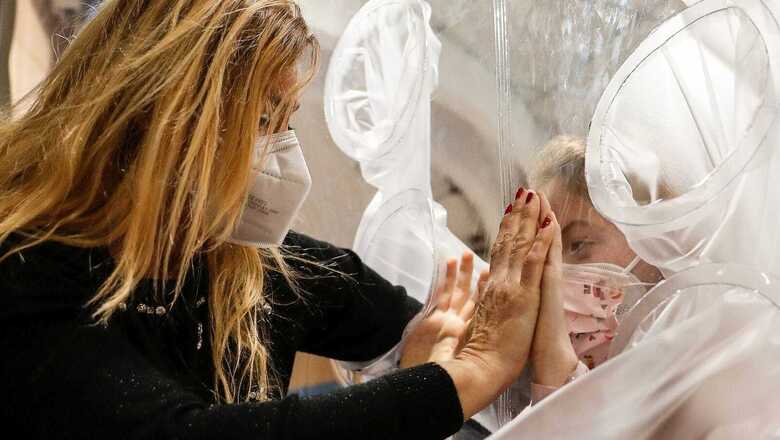
views
Even as India has kicked off its vaccination drive for teens aged 15 to 17, parents’ concerns are not over, as a perceived, although marginal, rise in hospitalisation of children is being reported amid the Omicron drive, across nations.
In the US, hospitalizations of US children under 5 with COVID-19 soared in recent weeks to their highest level since the pandemic began, according to government data released Friday on the only age group not yet eligible for the vaccine. A similar trend was reported from South Africa during the peak of the Omicron disease wave in the country.
The highly-transmissible variant was first reported in the country, and has now spread to most regions of the world. Although dubbed to cause a ‘milder’ illness than the Delta variant, Omicron has been associated with increased breakthrough infections and more transmissibility, in general.
In such a scenario, children, who around the world have not received shots as widely as adults and senior citizens, may risk being infected in greater numbers and driving up figures of the disease in the segment of the population. But whether the disease causes more severe illness in certain age groups is under debate, and upcoming figures are to be seen for a clearer picture.
According to a report by India Today, sources in the Indian Academy of Paediatrics said that 31 children under the age of 15 have been hospitalised in Delhi. Nine of them have been admitted to private hospitals. Doctors have advised caution, but have also stated that “most hospitalised cases are of comorbidity and report quick recovery with simple treatment,” the report states.
Two of the eight children who reported seizures have low blood pressure. Except for Covid-19, the others have pre-existing comorbidities.
The report further cites sources at Delhi’s Chacha Nehru Bal Chikitsalay, a prominent child speciality government hospital, as saying that two children under the age of two were admitted as Covid-19 patients, and daily paediatric cases are arriving in the OPD.
However, doctors treating the paediatric age group told India Today that “hospital admission is brief and results in quick recovery. The number of hospital admissions is not as high as the second wave”.
Meanwhile, health officials are monitoring Covid hospitalisation rates among children in India amid some evidence that a few countries are seeing higher numbers of kids in hospitals in the ongoing Omicron wave, reports had earlier stated.
Out of fear of being under-prepared, Indian states have reserved more than double the COVID-19 hospital beds recommended by federal experts, according to government data, even though doctors say not many children have needed critical care yet, the Mint reported.
According to data, India has more than 24,000 paediatric ICU beds, compared to a federal taskforce recommendation of fewer than 10,000 beds. Similarly, there are 64,796 non-ICU beds for children, which is significantly more than the recommended 27,682.
What’s Happening in the US?
Since mid-December, with the highly contagious omicron variant spreading furiously around the US, the hospitalisation rate in these youngest kids has surged to more than 4 in 100,000 children, up from 2.5 per 100,000.
The rate among children ages 5 to 17 is about 1 per 100,000, according to the CDC data, which is drawn from over 250 hospitals in 14 states.
Overall, “pediatric hospitalizations are at their highest rate compared to any prior point in the pandemic,” Walensky said.
She noted that just over 50% of children ages 12 to 18, and only 16% of those 5 to 11, are fully vaccinated.
The overall hospitalization rate among children and teens is still lower than that of any other age group. And they account for less than 5% of average new daily hospital admissions, according to the CDC.
As of Tuesday, the average number of under-18 patients admitted to the hospital per day with COVID-19 was 766, double the figure reported just two weeks ago.
The trend among the very youngest kids is being driven by high hospitalization rates in five states: Georgia, Connecticut, Tennessee, California and Oregon, with the steepest increases in Georgia, the CDC said.
How Can Such Date Be Perceived?
The increase in the US was observed in children who were 4 and younger, who are not eligible for vaccination, and the data included children who were admitted to hospitals for reasons other than COVID, the New York Times explained in its report.
The rise may be partly explained by the surge of omicron cases, which affects all populations, and the spread of other respiratory infections, it said.
According to the article, however, the data does not show a similar steep rise in coronavirus infections among hospitalized children of other ages, and federal health officials were considering the possibility that omicron may not be as mild in young children as it is older children.
Children infected with the variant are still at much less risk of becoming severely ill compared with adults, and even young children seem less likely to need ventilators than those admitted during previous surges, doctors said.
“We have not yet seen a signal that there is any increased severity in this age demographic,” Dr. Rochelle Walensky, the CDC’s director, told reporters at a news briefing Friday.
More than 4 in 100,000 children ages 4 and younger admitted to hospitals were infected with the coronavirus as of Jan. 1 — double the rate reported a month ago and about three times the rate this time last year.
By contrast, the rate of hospitalized 5- to 11-year-olds with COVID was 0.6 per 100,000, roughly the same figure reported over past many months.
Experts are typically cautious about interpreting an increase in pediatric hospitalizations as a sign that a variant is particularly severe in children relative to adults. There were similar fears about the delta and beta variants, but the rise in pediatric hospitalizations then turned out to be more a consequence of the contagiousness of the variants.
This time, too, at least part of the increase in cases is a reflection of omicron’s surge across all age groups. The nation is now recording roughly 600,000 cases on average per day, about 1 in 5 of them in children.
How to Protect Unvaccinated Children?
The worrisome trend in children too young to be vaccinated underscores the need for older kids and adults to get their shots to help protect those around them, said Dr. Rochelle Walensky, director of the Centers for Disease Control and Prevention.
The US’ top infectious-disease expert, Dr. Anthony Fauci, said earlier this week that omicron appears to cause less-severe disease across the board, but that the sheer number of infections because of its extreme contagiousness will mean that many more children will get infected, and a certain share of them will wind up in the hospital.
Fauci also said many children hospitalized with COVID-19 have other health conditions that make them more susceptible to complications from the virus. That includes obesity, diabetes and lung disease.
Fauci and Walensky have emphasized that one of the best ways to protect the youngest children is to vaccinate everyone else.
With inputs from the Associated Press, New York Times.
Read all the Latest India News here




















Comments
0 comment